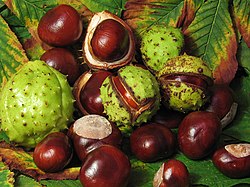Aesculus hippocastanum
| Horse Chestnut | |
|---|---|
 | |
| Binomial: | Aesculus hippocastanum |
| Family: | Sapindaceae |
Aesculus hippocastanum is a large deciduous tree, commonly known as Horse-chestnut. It is native to a small area in the mountains of the Balkans in southeast Europe, in small areas in northern Greece, Albania, the Republic of Macedonia, Serbia, and Bulgaria.[1] It is widely cultivated throughout the temperate world.
Description
[edit | edit source]
It grows to 36 m tall, with a domed crown of stout branches, on old trees the outer branches often pendulous with curled-up tips. The leaves are opposite and palmately compound, with 5-7 leaflets; each leaflet is 13–30 cm long, making the whole leaf up to 60 cm across, with a 7–20 cm petiole. The flowers are usually white with a small red spot; they are produced in spring in erect panicles 10–30 cm tall with about 20-50 flowers on each panicle. Usually only 1-5 fruit develop on each panicle; the fruit is a green, softly spiky capsule containing one (rarely two or three) nut-like seeds called conkers or horse-chestnuts. Each conker is 2–4 cm diameter, glossy nut-brown with a whitish scar at the base.
Growing Conditions
[edit | edit source]Varieties
[edit | edit source]Uses
[edit | edit source]
Cultivation for its spectacular spring flowers is successful in a range of climatic conditions provided summers are not too hot, with trees being grown as far north as Edmonton, Alberta,[2] the Faroe Islands,[3] and Tromsø, Norway. In more southern areas, growth is best in cooler mountain climates.
In Britain, the nuts are used for the popular children's game conkers. During the two world wars, horse-chestnuts were used as a source of starch which in turn could be used via the Clostridium acetobutylicum fermentation method devised by Chaim Weizmann to produce acetone. This acetone was then used as a solvent which aided in the process of ballistite extrusion into cordite, which was then used in military armaments.
The nuts, especially those that are young and fresh, are slightly poisonous, containing alkaloid saponins and glucosides. Although not dangerous to touch, they cause sickness when eaten. Some mammals, notably deer, are able to break down the toxins and eat them safely. They are reputed to be good for horses with wind, but this is unproven and feeding them to horses is not advisable. The saponin aescin, however, has been used for health purposes (such as varicose veins, edema, sprains) and is available in food supplements, as is a related glocoside aesculin.[4]


In the past, Horse-chestnut seeds were used in France and Switzerland for whitening hemp, flax, silk and wool. They contain a soapy juice, fit for washing of linens and stuffs, for milling of caps and stockings, etc., and for fulling of cloth. For this, 20 horse-chestnut seeds were sufficient for six liters of water. They were peeled, then rasped or dried, and ground in a malt or other mill. The water must be soft, either rain or river water; hard well water will not work. The nuts are then steeped in cold water, which soon becomes frothy, as with soap, and then turns milky white. The liquid must be stirred well at first, and then, after standing to settle, strained or poured off clear. Linen washed in this liquid, and afterwards rinsed in clear running water, takes on an agreeable light sky-blue colour. It takes spots out of both linen and wool, and never damages or injures the cloth.

In Bavaria the chestnut is the typical tree for a beer garden. Originally they were planted for their deep shade which meant that beer cellar owners could cut ice from local rivers and lakes in winter to cool their beer well into summer. Nowadays guests enjoy the shade to keep their heads cool - even after the second Maß (a mug with a liter of beer). Conkers have been threatened by the leaf-mining moth Cameraria ohridella, whose larvae feed on horse chestnut leaves. The moth had been in Europe since 1985 but took 17 years to reach Britain.
Aesculus hippocastanum is used in Bach flower remedies. When the buds are used it is referred to as "Chestnut Bud" and when the flowers are used it is referred to as "White Chestnut".
The flower is the symbol of the city of Kiev, capital of Ukraine.[5]
Horse-chestnuts can be used to make jewelry using the conkers as beads.
Maintenance
[edit | edit source]Propagation
[edit | edit source]Harvest
[edit | edit source]Pests and Diseases
[edit | edit source]References
[edit | edit source]- ↑ Euro+Med Plantbase Project: Aesculus hippocastanum
- ↑ Edmonton
- ↑ Højgaard, A., Jóhansen, J., & Ødum, S. (1989). A century of tree planting on the Faroe Islands. Ann. Soc. Sci. Faeroensis Supplementum 14.
- ↑ "Aesculin". Plant Poisons.
- ↑ Kiev
